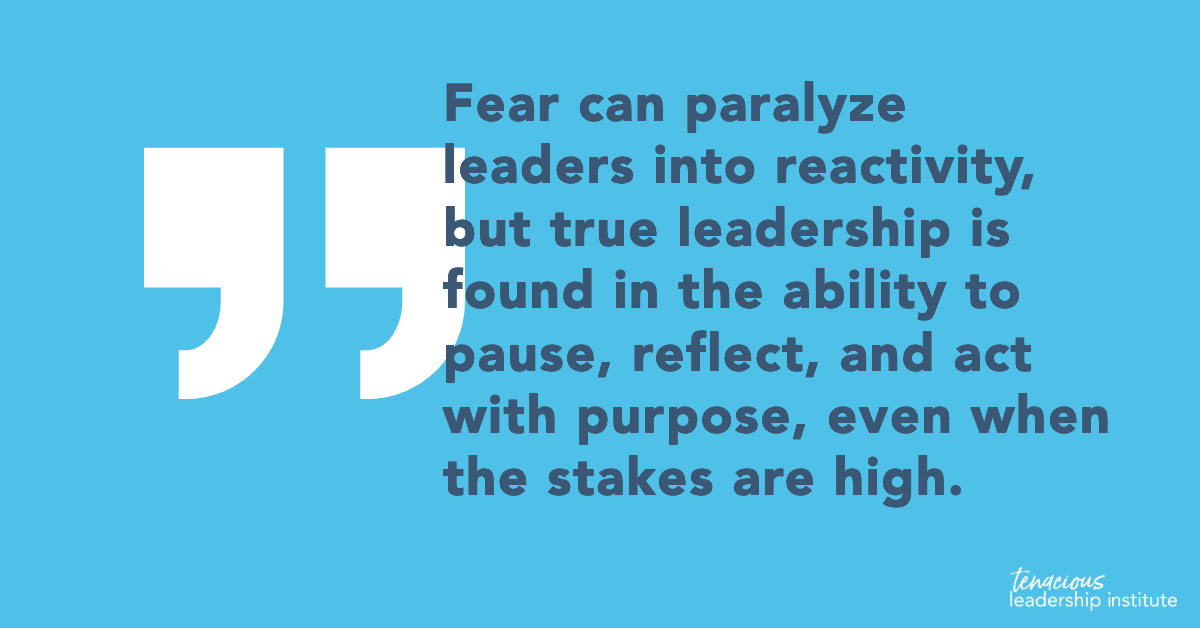5 Ways Fear During Disruption Can Actually Motivate You
In uncertain times, fear is often framed as something to push through or conquer. But what if fear isn’t the problem? What if it’s actually part of your leadership fuel?
Neuroscience tells us that fear activates the amygdala—a part of the brain that detects threat. But fear doesn’t just initiate panic or paralysis. It also primes the prefrontal cortex to pay closer attention, scan for patterns, and solve complex problems. When harnessed well, fear is not a weakness. It’s a wake-up call that enhances your leadership intelligence.
We recently worked with a COO at a global consumer brand whose company was undergoing a rapid digital transformation. As layoffs loomed, her fear spiked—not just about performance, but about preserving trust with her team. Instead of suppressing it, she named it, explored what it was pointing to (a core value of transparency), and used that awareness to guide her messaging and leadership stance. The result? A team that didn’t just weather the change—but stepped up with renewed loyalty and creativity. Fear, for her, became a catalyst.
Here are five ways fear can become a motivator during disruption—if you’re willing to listen.
1. Fear Sharpens Focus
When disruption hits, the noise increases: conflicting priorities, unclear direction, rising pressure. Fear, when acknowledged rather than suppressed, has a surprising benefit—it reduces distraction. In the brain, fear increases norepinephrine, which narrows attention and heightens awareness.
Many leaders experience this in crisis: suddenly, they’re clearer about what matters most. They let go of non-essential meetings, speed up decisions, and get laser-focused on outcomes. The difference isn’t always the crisis—it’s the fear creating internal urgency that overrides perfectionism and delay.
2. Fear Signals What Matters Most
Neuroscience shows that fear often originates from the same systems that govern emotional attachment and meaning-making. So when something triggers fear, it often reveals something deeply important—values, relationships, or goals that feel at risk.
Instead of labeling fear as irrational, leaders can ask: What’s this fear pointing to? One executive we worked with realized that his fear of layoffs wasn’t just about budget—it was about violating a value of integrity and care. That insight allowed him to lead with transparency and compassion, building trust even amid painful decisions.
3. Fear Fuels Courage
Courage isn’t the absence of fear—it’s taking aligned action despite it. In fact, the presence of fear activates the brain’s reward circuits more strongly when leaders take bold action. That means facing your fear can be more neurologically satisfying than avoiding it.
Think of a time you had a hard conversation, made a risky decision, or stood up for a principle under pressure. Fear was there. But so was energy. Neuroscience researcher Dr. Andrew Huberman notes that the sympathetic nervous system activation from fear can be channeled into drive and agency—when paired with purpose.
4. Fear Creates Relational Connection
Sharing fear can humanize a leader. But beyond optics, it builds real neurobiological connection. Research shows that vulnerability triggers oxytocin in teams, increasing trust and cohesion.
When leaders name their fears thoughtfully—not catastrophically—they invite shared resilience. “I don’t have all the answers, and yes, this change is unsettling. But we’ll move through it together.” That kind of clarity + vulnerability doesn’t weaken trust—it strengthens it.
5. Fear Unlocks Innovation
During fear states, the brain becomes hyper-attuned to threat—but it also becomes more open to novelty and pattern disruption. This can spark unconventional thinking, especially when fear is combined with psychological safety.
One TLI client team used their collective fear of market loss to rethink their entire product strategy. Instead of reacting in panic, they used structured dialogue to surface ideas they’d previously been too cautious to voice. Fear became a lever for bold ideation—not just reactive change.
Fear is not a sign of weakness—it’s an invitation to deepen your leadership. When you learn to decode and direct it, fear becomes a tool for alignment, courage, and decisive growth.
If you’re navigating fear or disruption and want support transforming it into clarity and momentum, reach out to us. Your fear has something to teach you—don’t miss the lesson.
Leadership Practice
The "Fear as Fuel" Reflection
Each morning this week, take 3 minutes and ask:
“What fear am I holding right now?”
“What might it be trying to protect or preserve?”
“How can I act from alignment instead of avoidance?”
Write down one small, aligned action you can take because of your fear—not in spite of it. Let fear show you what matters—and use it as fuel.
Author
Athena Williams, Founder and CEO of Tenacious Leadership Institute, has been supporting leaders worldwide to become more tenacious for over 20 years. She has found that tenacity is the key to sustained leadership success in today’s ever-changing world. Through her coaching and leadership development programs, she helps leaders expertly handle change, complexity and other challenges so they can quickly get better results for themselves, their teams and their organizations.
Take the first step to becoming a tenacious leader by scheduling a call with us.



